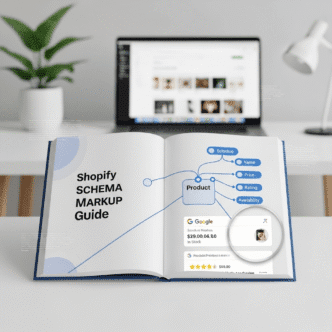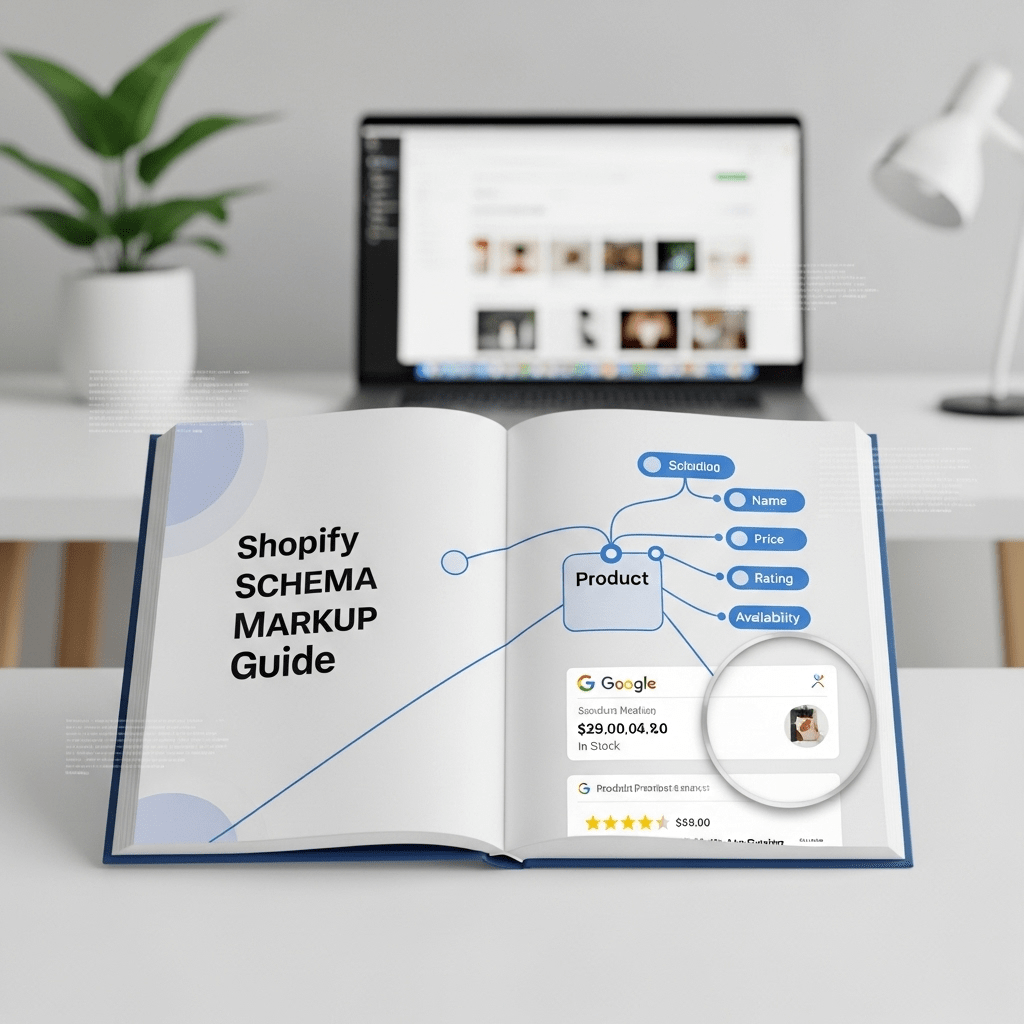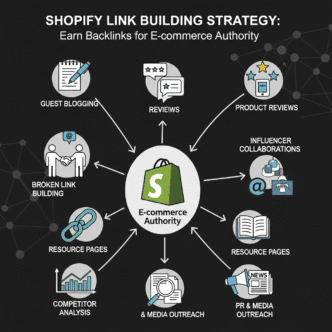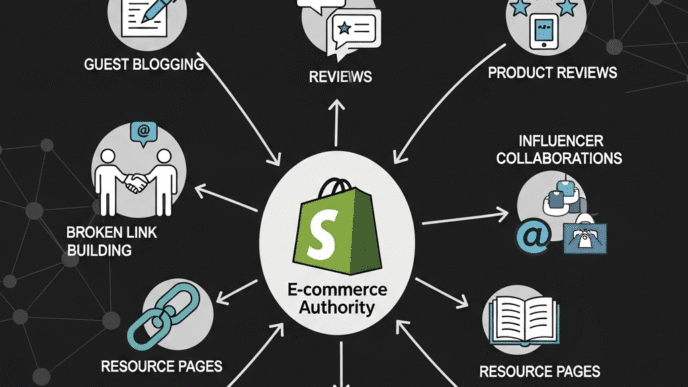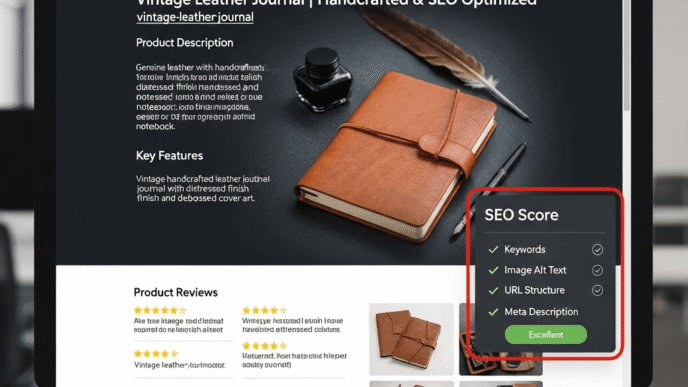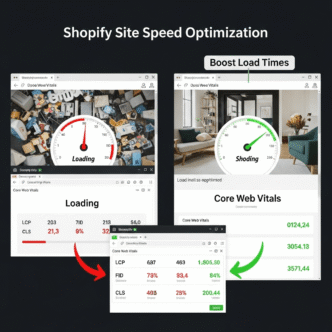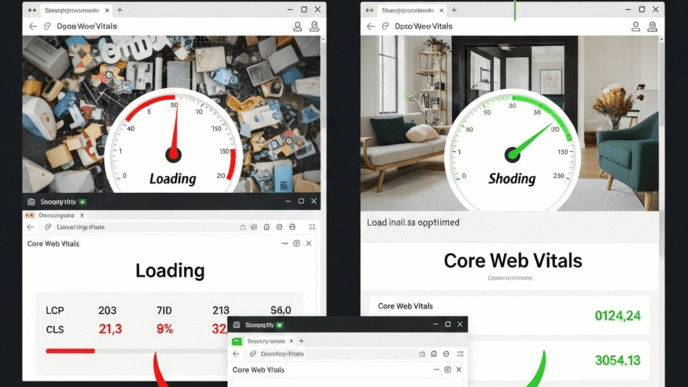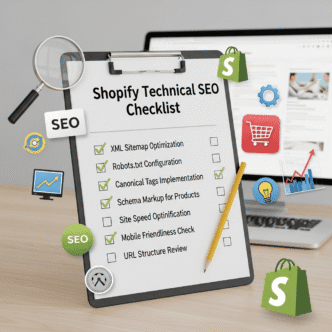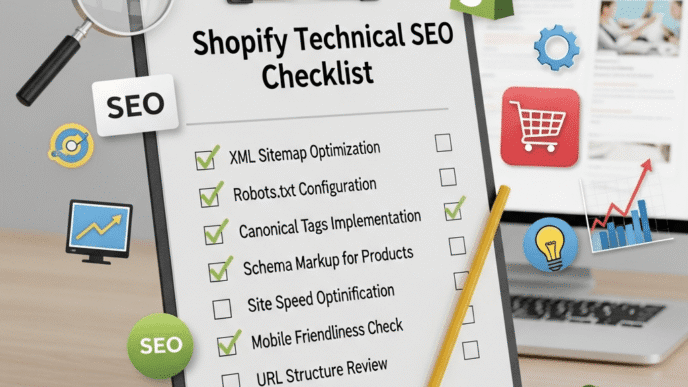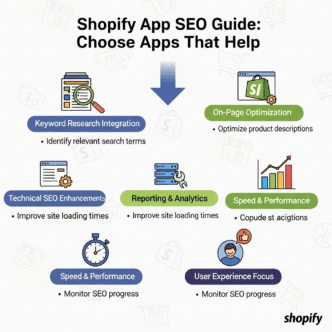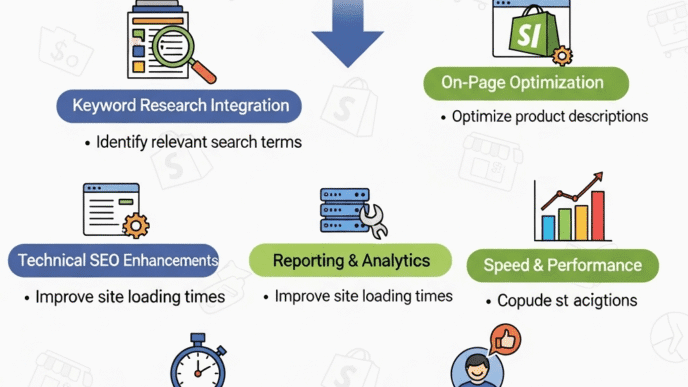Your Shopify products are invisible in search results. Not invisible as in “not ranking”—invisible as in plain, boring text listings that blend into the sea of competitors. Meanwhile, your competitors have shiny star ratings, prices, and “In Stock” labels staring searchers in the face.
Guess which listings get clicked?
Here’s the gut-punch: you’re losing 30-40% of potential clicks because you’re ignoring Shopify schema markup. Those eye-catching rich snippets with review stars, prices, and product details? They’re not magic—they’re structured data that tells Google exactly what your pages contain.
Most Shopify store owners have no idea schema markup even exists, or they think it’s some complex coding nightmare requiring a developer on retainer. Meanwhile, stores that implement proper product schema are stealing clicks, traffic, and sales right from under everyone’s nose.
The truth? Structured data implementation on Shopify isn’t rocket science—but it does require understanding what you’re doing and why. Slap it on wrong, and Google ignores it. Get it right, and you transform boring search listings into click-magnets with star ratings, prices, availability, and more.
In this comprehensive guide, I’ll show you exactly how to add schema markup to Shopify for better search visibility—from understanding what schema is to implementing it correctly to testing and troubleshooting. No developer required.
Let’s turn your invisible listings into attention-grabbing rich snippets.
Table of Contents
ToggleWhat Is Schema Markup and Why Should You Care?
Schema markup (also called structured data) is code you add to your website that helps search engines understand what your content means, not just what it says.
Think of it like this: Google reads your product page and sees “Nike Air Max 270 – $150.” But does it know that’s a product name and price? Not without schema. With schema, you’re explicitly telling Google: “This is a Product. Here’s the name, price, availability, and ratings.”
Why Schema Markup Matters for Shopify Stores
Rich Snippets = Higher Click-Through Rates: Search results with star ratings get 35% more clicks than plain listings (according to Moz research). That’s free traffic.
Competitive Advantage: Most Shopify stores don’t implement schema properly. Yours will stand out.
Voice Search Optimization: Schema helps voice assistants understand your products for “near me” and product searches.
Better Understanding by Google: Schema helps Google accurately categorize and display your products, collections, and content.
Enhanced Mobile Results: Rich snippets are even more prominent on mobile, where screen space is limited.
The bottom line? Schema markup is the difference between a boring text listing and a visually enhanced result that screams “click me!”
For foundational Shopify SEO strategies before diving into schema, start with our definitive Shopify SEO guide.
What Do Rich Snippets Actually Look Like?
Let’s get visual. When you search for products on Google, you’ve definitely seen rich snippets—you just might not have known what they’re called.
Types of Rich Snippets for E-commerce
Product Rich Snippets show:
- Product name
- Price (or price range)
- Star rating (⭐⭐⭐⭐⭐)
- Number of reviews
- Availability (In Stock, Out of Stock)
- Product image
Review Rich Snippets display:
- Overall rating (4.8 out of 5 stars)
- Total review count
- Individual review highlights
Organization Snippet shows:
- Business name
- Logo
- Social media links
- Contact information
Breadcrumb Snippets display:
- Site hierarchy (Home > Men’s Shoes > Running Shoes)
- Makes navigation clearer in search results
FAQ Snippets show:
- Question and answer expandable sections
- Directly in search results
Video Snippets display:
- Video thumbnail
- Duration
- Upload date
Pro Tip: According to Search Engine Journal’s analysis, product pages with proper schema markup and review stars see an average 35% increase in click-through rate compared to plain listings. That’s massive for the same rankings.
Does Shopify Include Schema Markup by Default?
Good news: Shopify automatically includes basic schema markup on your store. Bad news: it’s often incomplete and needs enhancement.
What Shopify Includes Automatically
Product Schema: Basic product information (name, description, image, price)
Organization Schema: Your store’s basic business information
WebSite Schema: Information about your website
Breadcrumb Schema: Navigation hierarchy (in most themes)
What’s Often Missing or Incomplete
Review/Rating Schema: Shopify doesn’t include review markup unless you use review apps
Detailed Product Attributes: Size, color, material, SKU, brand details
Availability Schema: Proper in-stock/out-of-stock status
Offer Schema: Sale prices, valid through dates, shipping details
AggregateRating: Overall rating from multiple reviews
Video Schema: Product video markup
FAQ Schema: Product questions and answers
So yes, Shopify gives you a foundation—but you need to build on it for maximum impact.
How Do You Check Your Current Schema Markup?
Before adding or fixing schema, see what you already have.
Schema Testing Tools
| Tool | Purpose | Cost | Best For |
|---|---|---|---|
| Google Rich Results Test | Validate schema & preview rich snippets | Free | Quick checks, seeing preview |
| Schema Markup Validator | Comprehensive schema validation | Free | Detailed technical validation |
| Google Search Console | See which pages have rich results | Free | Monitoring actual performance |
| Screaming Frog SEO Spider | Bulk schema audit across entire site | Free (500 URLs) | Large site audits |
| Shopify Schema Apps | App-based validation & fixing | $5-30/mo | Easy fixes without code |
Step-by-Step Schema Audit Process
Step 1: Go to Google’s Rich Results Test
Step 2: Enter your product page URL
Step 3: Click “Test URL”
Step 4: Review results:
- Green checkmarks = schema detected and valid
- Yellow warnings = issues to fix
- Red errors = broken schema
Step 5: Check “Code” tab to see actual schema markup
Step 6: Repeat for different page types (product, collection, blog)
Common Issues You’ll Find:
- Missing review schema (no star ratings possible)
- Incorrect price format
- Missing availability status
- Broken image URLs in schema
- Missing required fields
Real example: A fashion store tested their product pages and discovered their review app wasn’t generating proper schema. After switching to Judge.me (which includes schema), they got star ratings in search results within 3 weeks—and CTR increased 28%.
External resource: Google’s Introduction to Structured Data provides official guidance on implementation.
What Types of Schema Should Shopify Stores Implement?
Not all schema types are relevant for e-commerce. Focus on what matters.
Essential Schema Types for Shopify
1. Product Schema
The foundation of e-commerce schema. Tells Google this is a product page.
Required Properties:
- name
- image
- description
- offers (price, currency, availability)
Recommended Properties:
- brand
- sku
- gtin (Global Trade Item Number)
- aggregateRating (from reviews)
- review (individual reviews)
2. Offer Schema (nested in Product)
Details about pricing and availability.
Properties:
- price
- priceCurrency
- availability (InStock, OutOfStock, PreOrder)
- priceValidUntil (for sales)
- url (product page link)
3. AggregateRating Schema
Overall rating from all reviews.
Properties:
- ratingValue (e.g., 4.5)
- reviewCount (e.g., 247 reviews)
- bestRating (usually 5)
- worstRating (usually 1)
4. Review Schema
Individual customer reviews.
Properties:
- author
- datePublished
- reviewBody
- reviewRating
5. Breadcrumb Schema
Shows navigation path in search results.
Properties:
- itemListElement (array of breadcrumb items)
- position (order in hierarchy)
6. Organization Schema
Business information (sitewide).
Properties:
- name
- logo
- url
- contactPoint
- sameAs (social media links)
7. FAQ Schema
For FAQ pages or product Q&A sections.
Properties:
- mainEntity (array of questions and answers)
8. Video Schema (if applicable)
For product videos.
Properties:
- name
- description
- thumbnailUrl
- uploadDate
- duration
Pro Tip: According to Merkle’s schema markup study, Product schema with reviews is 94% more likely to earn rich snippets than Product schema alone. Prioritize getting reviews and review schema implemented.
For comprehensive technical SEO beyond schema, check our Shopify SEO guide.
How Do You Add Product Schema to Shopify Manually?
If you want full control, adding schema manually gives you that power—but requires some technical comfort.
Understanding JSON-LD Format
Shopify (and Google) uses JSON-LD format for schema. It looks like this:
<script type="application/ld+json">
{
"@context": "https://schema.org",
"@type": "Product",
"name": "Men's Running Shoes",
"image": "https://yourstore.com/images/running-shoes.jpg",
"description": "Lightweight running shoes with superior cushioning",
"brand": {
"@type": "Brand",
"name": "YourBrand"
},
"offers": {
"@type": "Offer",
"price": "89.99",
"priceCurrency": "USD",
"availability": "https://schema.org/InStock",
"url": "https://yourstore.com/products/running-shoes"
}
}
</script>
This code goes in your theme’s HTML, typically in the product page template.
Where to Add Schema in Shopify Theme
Location: product.liquid or main-product.liquid (Shopify 2.0 themes)
Access: Online Store → Themes → Actions → Edit code
Section to Edit: Look for product template files in the “Sections” or “Templates” folder
Step-by-Step Manual Implementation
Step 1: Backup your theme first (Actions → Duplicate)
Step 2: Go to Edit Code
Step 3: Find your product template (usually main-product.liquid or product.liquid)
Step 4: Add schema code using Liquid variables:
<script type="application/ld+json">
{
"@context": "https://schema.org",
"@type": "Product",
"name": "{{ product.title | escape }}",
"image": "{{ product.featured_image | img_url: 'grande' | prepend: 'https:' }}",
"description": "{{ product.description | strip_html | escape }}",
"brand": {
"@type": "Brand",
"name": "{{ shop.name }}"
},
"sku": "{{ product.selected_or_first_available_variant.sku }}",
"offers": {
"@type": "Offer",
"price": "{{ product.selected_or_first_available_variant.price | divided_by: 100.0 }}",
"priceCurrency": "{{ cart.currency.iso_code }}",
"availability": "{% if product.available %}https://schema.org/InStock{% else %}https://schema.org/OutOfStock{% endif %}",
"url": "{{ shop.url }}{{ product.url }}"
}
}
</script>
Step 5: Save and test with Google’s Rich Results Test
Step 6: Add review schema if you have reviews (more on this below)
Important: This is simplified. Real implementations need proper formatting, escaping, and handling of edge cases.
Manual Schema Pros and Cons
Pros:
- Complete control
- No monthly app fees
- Faster page load (no extra app code)
- Customizable to your exact needs
Cons:
- Requires technical knowledge
- Easy to break if not careful
- Must update manually when schema.org changes
- Time-consuming for large stores
- Harder to maintain across theme updates
Recommendation: Manual implementation is best if you’re technical or have a developer. Most store owners should use apps (covered next).
What Are the Best Shopify Schema Markup Apps?
Apps make schema implementation dramatically easier—at the cost of monthly fees and potential performance impact.
Top Schema Markup Apps for Shopify
| App | Features | Price | Best For | Performance Impact |
|---|---|---|---|---|
| JSON-LD for SEO | Comprehensive schema, reviews, FAQ, breadcrumbs | $14.99/mo | Most stores (recommended) | Low |
| Smart SEO | Auto schema, meta tags, image optimization | $4.99/mo | Budget option with schema | Medium |
| SEO Manager | Bulk schema, redirects, meta management | $20/mo | Large catalogs | Low-Medium |
| Booster SEO & Image Optimizer | Schema + speed optimization | Free-$34.95/mo | Combining features | Medium |
| Plug in SEO | Schema + SEO issue detection | Free-$20/mo | Identifying and fixing issues | Low |
| Schema Plus for SEO | Advanced schema customization | $9.99/mo | Custom schema needs | Low |
Detailed App Analysis
JSON-LD for SEO (Most Recommended)
What it does:
- Automatic Product, Organization, Breadcrumb schema
- Review schema integration with major review apps
- FAQ schema for product Q&A
- Video schema for product videos
- LocalBusiness schema for stores with physical locations
Pros:
- Comprehensive coverage
- Works with most review apps (Judge.me, Loox, Yotpo)
- Clean JSON-LD implementation
- Regular updates for schema.org changes
Cons:
- $14.99/month ongoing cost
- Some overlap with Shopify’s default schema
Best for: Most Shopify stores wanting complete schema coverage without coding
Smart SEO (Budget Option)
What it does:
- Auto-generates product schema
- Meta tag optimization
- Basic structured data
- Image alt tag automation
Pros:
- Only $4.99/month
- Includes non-schema SEO features
- Good for small stores
Cons:
- Less comprehensive schema than JSON-LD
- Some users report conflicts with themes
- Limited customization
Best for: Budget-conscious stores with basic schema needs
SEO Manager (For Power Users)
What it does:
- Advanced schema management
- Bulk editing of schema across products
- 301 redirects management
- Meta tag bulk editing
Pros:
- Powerful bulk features for large catalogs
- Includes redirect management
- Professional-level control
Cons:
- $20/month
- Steeper learning curve
- Some features overlap with other needs
Best for: Large stores (500+ products) needing bulk management
How to Choose the Right Schema App
Decision Framework:
Small store (under 100 products), limited budget → Smart SEO
Medium store (100-500 products), serious about SEO → JSON-LD for SEO
Large store (500+ products), need bulk management → SEO Manager
Want schema + other SEO features → Booster SEO or Smart SEO
DIY approach, just need validation → Plug in SEO (for finding issues, implement manually)
Pro Tip: Install apps one at a time and test with Google’s Rich Results Test after each. Some apps conflict with each other or with Shopify’s default schema, creating duplicate or broken structured data.
How Do You Add Review Schema for Star Ratings?
Review schema is the golden ticket to star ratings in search results—the most visually compelling rich snippet.
Review App Schema Comparison
Not all review apps generate proper schema. Here’s what works:
| Review App | Auto Schema? | Quality | Price | Stars in Search? |
|---|---|---|---|---|
| Judge.me | Yes | Excellent | Free-$15/mo | ✅ Yes |
| Loox | Yes | Good | $9.99-$299/mo | ✅ Yes |
| Yotpo | Yes | Excellent | Free-$599/mo | ✅ Yes |
| Stamped.io | Yes | Good | $23-$149/mo | ✅ Yes |
| Shopify Product Reviews | No | N/A | Free | ❌ No schema |
| Rivyo | Yes | Fair | Free-$9.99/mo | ⚠️ Sometimes |
Recommendation: Judge.me offers the best value—excellent schema implementation, photo reviews, and reasonable pricing.
Implementing Review Schema Step-by-Step
Step 1: Install a review app that generates schema (Judge.me, Loox, Yotpo)
Step 2: Import or collect product reviews
Step 3: Verify schema is generated:
- Go to a product page with reviews
- View page source (right-click → View Page Source)
- Search for “aggregateRating” or “review”
- Should see JSON-LD code with review data
Step 4: Test with Google’s Rich Results Test
Step 5: Submit URL to Google Search Console for re-indexing
Step 6: Wait 1-4 weeks for stars to appear in search results
Why Review Stars Might Not Appear
Even with proper schema, stars don’t always show:
Insufficient Reviews: Google typically requires 3-5 reviews minimum per product
Too New: Takes 1-4 weeks after schema implementation for Google to display stars
Policy Violations: Self-reviews, fake reviews, or incentivized reviews violate Google’s guidelines
Schema Errors: Broken or invalid schema markup
Google’s Discretion: Google doesn’t guarantee rich snippets even with perfect schema
Competitive Factors: In highly competitive SERPs, Google may not show rich snippets
Review Schema Best Practices
✅ Get Real Reviews: Encourage genuine customer feedback
✅ Respond to Reviews: Shows engagement and authenticity
✅ Include Photo Reviews: Higher engagement and trust
✅ Don’t Fake Reviews: Google detects patterns and penalizes
✅ Include Review Dates: Shows recency and authenticity
✅ Use Schema for All Products: Not just bestsellers
❌ Don’t Use Self-Reviews: Owner/employee reviews violate guidelines
❌ Don’t Incentivize Positive-Only: Incentivize reviews generally, not specifically positive ones
❌ Don’t Use Review Gating: Don’t only ask happy customers for reviews
Real example: A supplement store switched from Shopify’s default review app (no schema) to Judge.me. After collecting 500+ reviews across 40 products, star ratings appeared in search results for 32 products. CTR on those products increased 41% on average, driving an additional $12,000 monthly revenue.
External resource: Google’s Review Snippet Guidelines provides official rules for review schema implementation.
How Do You Add FAQ Schema to Product Pages?
FAQ schema can get your product Q&A featured directly in search results—capturing attention above the fold.
When to Use FAQ Schema
Product Pages with Q&A: Customer questions about sizing, specifications, usage
Help/Support Pages: Common questions about shipping, returns, policies
Blog Posts: Comprehensive guides with Q&A sections
Collection Pages: Category-level FAQs
Manual FAQ Schema Implementation
<script type="application/ld+json">
{
"@context": "https://schema.org",
"@type": "FAQPage",
"mainEntity": [{
"@type": "Question",
"name": "What size should I order?",
"acceptedAnswer": {
"@type": "Answer",
"text": "Our shoes run true to size. Consult our size guide for measurements."
}
}, {
"@type": "Question",
"name": "How long does shipping take?",
"acceptedAnswer": {
"@type": "Answer",
"text": "Standard shipping takes 3-5 business days within the US."
}
}]
}
</script>
Add this to pages with FAQ content, either manually in theme code or via apps.
FAQ Schema Apps
| App | Features | Price |
|---|---|---|
| JSON-LD for SEO | FAQ schema + other types | $14.99/mo |
| FAQ Page by Expert Village | FAQ builder + schema | Free |
| HelpCenter | FAQ builder with auto-schema | $9.99-$29.99/mo |
FAQ Schema Best Practices
✅ Answer Genuinely: Don’t stuff keywords unnaturally
✅ Keep Answers Concise: 2-4 sentences per answer
✅ Use Real Customer Questions: Base FAQs on actual inquiries
✅ Update Regularly: Keep information current
✅ Don’t Mislead: Answers must accurately address questions
❌ Don’t Use for Advertising: FAQs aren’t for promotional content
❌ Don’t Repeat Content: Each Q&A should be unique
Pro Tip: According to SEMrush research, pages with FAQ schema are 40% more likely to appear in voice search results. Voice assistants love pulling answers from properly marked-up FAQs.
How Do You Test and Validate Your Schema Markup?
Implementation is half the battle. Validation ensures it actually works.
Testing Tools and Process
1. Google Rich Results Test (Primary Tool)
Visit: https://search.google.com/test/rich-results
Process:
- Enter your URL
- Click “Test URL”
- Review detected schema types
- Check for errors or warnings
- Click “Preview” to see how it might appear in search
What to Look For:
- Green checkmarks (valid schema detected)
- Preview shows star ratings, price, availability
- No critical errors (red)
- Warnings are okay (yellow) but fix when possible
2. Schema Markup Validator
Visit: https://validator.schema.org/
Process:
- Paste URL or code
- Click “Run Test”
- Review detailed validation results
- Fix any errors or warnings
More technical than Rich Results Test but more comprehensive.
Process:
- Go to Enhancements section
- Check “Product” or other relevant reports
- See which pages have valid schema
- Monitor issues over time
- Track rich results performance
This shows real-world performance, not just validation.
4. Screaming Frog SEO Spider
For bulk validation:
- Crawl your entire site
- Check “Structured Data” tab
- Export schema data
- Identify pages missing schema
- Find duplicate or conflicting schema
Best for large stores auditing hundreds of products.
Common Schema Errors and Fixes
Error: Missing Required Field
Problem: Schema lacking mandatory properties (name, image, price)
Fix: Add missing properties to your schema code
Error: Invalid Price Format
Problem: Price as “$89.99” instead of “89.99”
Fix: Remove currency symbols, use numbers only with priceCurrency field
Error: Invalid URL
Problem: Relative URLs (
/products/shoes) instead of absolute (https://store.com/products/shoes)
Fix: Use full URLs with https:// prefix
Error: Missing aggregateRating
Problem: No review schema despite having reviews
Fix: Ensure review app generates schema, or add manually
Error: Incorrect availability Value
Problem: Using “In Stock” instead of “https://schema.org/InStock”
Fix: Use proper schema.org vocabulary values
Error: Duplicate Schema
Problem: App and theme both generate schema, creating duplicates
Fix: Disable one source (usually disable app if theme has good schema)
Validation Checklist
Before considering schema “done”:
- [ ] Tested all product pages with Rich Results Test
- [ ] Tested collection pages
- [ ] Tested blog posts (if using schema there)
- [ ] Verified in Google Search Console
- [ ] No critical errors (red)
- [ ] Rich snippet preview looks correct
- [ ] Schema matches actual page content
- [ ] Review schema present (if you have reviews)
- [ ] Breadcrumb schema working
- [ ] Organization schema correct
Real example: A home goods store thought their schema was perfect until they tested with Screaming Frog. They discovered 127 products had broken image URLs in schema (404 errors), 43 had price format errors, and 89 were missing availability status. After fixes, 76% of products started showing rich snippets within 3 weeks.
For comprehensive technical SEO testing beyond schema, revisit our Shopify SEO guide.
How Long Does It Take for Rich Snippets to Appear?
Patience, grasshopper. Rich snippets don’t appear instantly.
Typical Timeline
Week 1: Implement schema, test validation
Week 2: Submit URLs to Google Search Console for indexing
Weeks 2-4: Google crawls and processes schema
Weeks 3-6: Rich snippets begin appearing in search results
Weeks 6-12: Full rollout across all eligible pages
Factors Affecting Timeline:
- How often Google crawls your site (more authority = faster)
- Competition in your niche (competitive SERPs may not show snippets)
- Schema quality (perfect schema appears faster)
- Review count (more reviews = more likely to show)
- Page authority (stronger pages get snippets faster)
How to Speed Up Rich Snippet Appearance
1. Request Indexing in Search Console
- Go to URL Inspection tool
- Enter your URL
- Click “Request Indexing”
- Do this for top 20-30 products
2. Update Sitemaps
- Ensure product pages are in XML sitemap
- Submit sitemap to Search Console
- Monitor indexation status
3. Build Links to Product Pages
- Internal links from blog posts
- External links from reviews, features
- Social media sharing
- Higher authority pages get processed faster
4. Keep Content Fresh
- Update product descriptions regularly
- Add new reviews
- Update images
- Fresh content gets crawled more frequently
Why Rich Snippets Might Not Appear
Even with perfect schema:
Insufficient Reviews: Need 3-5 minimum for stars
Low Search Volume: Google may not show snippets for rarely-searched products
Highly Competitive SERPs: Google limits snippets in crowded results
Policy Violations: Fake reviews, misleading info
Google’s Algorithm: Google decides when/where to show rich results
Multiple Schema Issues: Conflicting or duplicate schema
New Site: Newer domains take longer to earn rich snippets
Pro Tip: According to BrightEdge research, only 35% of eligible pages actually display rich snippets in search results. Google is selective. Focus on your bestselling products and highest-traffic pages first—they’re most likely to earn rich snippets.
What Are Common Schema Markup Mistakes to Avoid?
Let’s talk about the facepalm-worthy errors that tank schema implementations.
Mistake #1: Using Multiple Schema Sources
The Problem: Theme generates schema, app generates schema, manual code adds more—creating duplicate and conflicting structured data.
The Fix: Choose ONE source. Disable others. Test to confirm only one schema block exists per page.
Mistake #2: Fake or Misleading Reviews
The Problem: Creating fake reviews to get star ratings faster.
The Fix: Only use genuine customer reviews. Google detects patterns and penalizes.
Mistake #3: Schema Doesn’t Match Page Content
The Problem: Schema says “In Stock” but page shows “Out of Stock.” Or price in schema differs from displayed price.
The Fix: Ensure schema dynamically reflects actual page content using Liquid variables.
Mistake #4: Missing Required Properties
The Problem: Incomplete schema missing mandatory fields like price, availability, or image.
The Fix: Validate with Google’s tools. Add all required properties.
Mistake #5: Wrong Schema Type
The Problem: Using “Offer” when you should use “Product” or mixing types incorrectly.
The Fix: Follow schema.org documentation for proper type hierarchy.
Mistake #6: Invalid URL Formats
The Problem: Relative URLs, missing https://, or broken links in schema.
The Fix: Use absolute URLs with proper protocol throughout schema.
Mistake #7: Incorrect Price Format
The Problem: Including currency symbols in price field: “$89.99” instead of “89.99”
The Fix: Use numeric values only. Specify currency separately with priceCurrency.
Mistake #8: Not Testing After Theme Updates
The Problem: Theme updates break custom schema code, but you don’t notice for months.
The Fix: Test schema after every theme update or major change.
Mistake #9: Ignoring Warnings
The Problem: Dismissing yellow warnings in validation tools as unimportant.
The Fix: Address warnings when possible—they can prevent rich snippet display.
Mistake #10: Setting Unrealistic Expectations
The Problem: Expecting instant rich snippets and 500% CTR increase.
The Fix: Understand schema takes time (weeks) and rich snippets aren’t guaranteed, but when they appear, expect 20-40% CTR boost.
A tech accessories store made mistake #1—their theme, a schema app, and manual code all generated product schema. Google saw three conflicting Product schemas per page and showed none. After disabling the app and removing manual code (keeping theme schema only), rich snippets appeared within 2 weeks.
How Do You Leverage AI for Schema Markup in 2025?
AI-powered tools are making schema implementation easier—use them strategically.
AI Applications for Schema Markup
Use ChatGPT or Claude to generate schema code:
Prompt Example: “Generate JSON-LD Product schema for a Shopify product with these details: [product name, price, description, availability]. Include offer schema and aggregate rating placeholder.”
AI generates properly formatted code you can customize.
2. AI Schema Validation
Ask AI to review your schema for errors:
“Review this schema markup for errors and suggest improvements: [paste schema code]”
AI identifies syntax errors, missing properties, and optimization opportunities.
3. AI FAQ Generation
Generate FAQ schema content:
“Create 5 frequently asked questions and answers about [product] for FAQ schema implementation.”
Then format into proper FAQ schema.
4. AI Schema Documentation
Don’t understand schema.org documentation?
“Explain what ‘aggregateRating’ property means in Product schema and show an example.”
AI breaks down complex technical concepts.
AI Tools for Schema
ChatGPT/Claude: Code generation, validation, explanation
Schema App (uses AI): Automated schema creation and management
Jasper/Copy.ai: Generate FAQ content for FAQ schema
GitHub Copilot: Code completion for developers
AI Limitations for Schema
What AI Can’t (Yet) Do:
❌ Implement directly in Shopify: You still need to add code manually or via apps
❌ Test in real-time: Use Google’s tools for validation, not just AI
❌ Guarantee compliance: AI might generate outdated schema formats
❌ Replace understanding: You should understand what the schema does, not blindly copy
The AI + Human Approach
Best Practice:
- Use AI to generate initial schema code
- Review and customize for your specific needs
- Test with Google’s Rich Results Test
- Implement carefully in Shopify
- Monitor performance and iterate
Pro Tip: AI-generated schema is a starting point, not a finished product. Always validate with official Google tools and test in your actual Shopify environment before considering it production-ready.
Final Thoughts: Your Schema Markup Action Plan
Let’s wrap this up with a clear roadmap for Shopify schema markup success.
Week 1: Audit and Assessment
- Test current schema with Google’s Rich Results Test
- Check 5-10 product pages, collection pages, homepage
- Document what’s working and what’s missing
- List priority pages for optimization
- Choose implementation method (app vs. manual)
Week 2: Foundation Implementation
- Implement/verify Product schema on all products
- Ensure Organization schema correct
- Verify Breadcrumb schema working
- Test changes with validation tools
Week 3: Review Schema
- Install review app with proper schema (Judge.me, Loox, Yotpo)
- Collect initial reviews (email past customers)
- Verify review schema generating correctly
- Test with Rich Results Test
Week 4: Advanced Schema
- Add FAQ schema to relevant pages
- Implement Video schema if you have product videos
- Enhance Product schema with all recommended properties
- Add Local Business schema if you have physical location
Weeks 5-8: Monitoring and Optimization
- Submit key URLs to Search Console for re-indexing
- Monitor for rich snippet appearances
- Track CTR changes in Search Console
- Address any new errors
- Document what’s working
Ongoing: Maintenance
- Test schema after theme updates
- Verify schema on new products
- Monitor Search Console enhancements reports
- Update schema when schema.org releases changes
- Expand review collection efforts
The Non-Negotiables:
✅ Valid Product schema on every product page
✅ Review schema if you have reviews (critical for star ratings)
✅ Proper price and availability markup
✅ No duplicate or conflicting schema
✅ Regular validation testing
✅ Breadcrumb schema for site hierarchy
✅ Organization schema sitewide
✅ Monitor Search Console for errors
The Bottom Line:Shopify schema markup isn’t optional anymore—it’s table stakes for competitive e-commerce SEO. The difference between a plain search listing and one with 5-star ratings, price, and “In Stock” label is 30-40% CTR difference.
Your competitors either don’t know about schema or think it’s too technical. That’s your advantage.
The stores dominating search results in 2025 aren’t just ranking—they’re converting clicks with visually enhanced rich snippets that command attention.
Every day without proper schema is clicks, traffic, and revenue left on the table. Your products deserve to shine in search results, not hide in plain text.
For your complete Shopify SEO strategy—technical optimization, content marketing, speed optimization, and more—bookmark our definitive Shopify SEO guide.
Stop blending into the search result crowd. Start standing out with rich snippets.
Implement schema markup today. Your CTR (and bank account) will thank you.
Frequently Asked Questions (FAQs)
Q: Do I really need schema markup if Shopify includes it by default? A: Yes. Shopify’s default schema is basic—typically lacking review schema, detailed product attributes, and proper offer markup. Enhancing default schema with apps or manual code significantly increases your chances of earning rich snippets with star ratings.
Q: How long after implementing schema will star ratings appear in search? A: Typically 2-6 weeks. Factors include: how often Google crawls your site, review count (need 3-5 minimum), schema quality, and page authority. Submit URLs to Search Console to potentially speed this up, but patience is required.
Q: Can schema markup hurt my SEO if implemented incorrectly? A: Incorrect schema won’t directly harm rankings, but it wastes opportunity. Broken schema prevents rich snippets, and seriously invalid markup might trigger manual actions if Google detects intentional manipulation. Always validate before deploying.
Q: Which review app is best for schema markup? A: Judge.me offers the best value—excellent schema implementation, photo reviews, reasonable pricing (free-$15/mo). Alternatives include Loox ($9.99+/mo) and Yotpo (free-$599/mo for enterprise). All three generate proper review schema for star ratings.
Q: Do I need separate schema for each product variant? A: No. One Product schema per product page covers all variants. Use Shopify’s variant system (dropdown selectors) and ensure schema dynamically reflects the selected variant’s price and availability using Liquid variables.
Q: Will schema markup guarantee rich snippets in search results? A: No. Schema makes you eligible, but Google decides whether to display rich results based on relevance, competition, query type, and quality. Properly implemented schema with reviews shows rich snippets about 35-60% of the time according to industry data.
Q: Should I use a schema app or implement manually? A: Apps (JSON-LD for SEO, Smart SEO) are easier and include updates when schema.org standards change. Manual implementation offers more control and no monthly fees but requires technical knowledge. For most stores, apps are worth the $5-20/month.
Q: Can I use schema markup for product videos? A: Yes. Video schema (VideoObject) can be nested within Product schema or used separately. Includes properties like name, description, thumbnailUrl, uploadDate, and duration. Helps videos appear in video search results and may show video thumbnails in regular search.
Q: How do I get the “In Stock” or “Out of Stock” label in search results? A: Implement proper Offer schema with availability property. Use https://schema.org/InStock when available, https://schema.org/OutOfStock when unavailable. Ensure this updates dynamically based on actual inventory status.
Q: What’s the difference between schema markup and meta tags? A: Meta tags (title, description) control how your listing appears in search results. Schema markup provides structured data helping search engines understand your content, potentially earning rich snippets (stars, price, etc.). Both are important and serve different purposes.
Q: Do I need schema on collection/category pages? A: Yes. CollectionPage schema helps Google understand these are category pages. Include basic properties (name, description, url) and breadcrumbs. While not as critical as product schema, it provides additional context for search engines.
Q: Can incorrect schema cause a Google penalty? A: Rarely. Invalid schema typically just doesn’t display as rich results. However, intentionally misleading schema (fake reviews, incorrect prices, manipulative markup) can trigger manual actions. Always ensure schema accurately reflects page content.
Advanced Schema Strategies for Competitive Advantage
Since we’re being comprehensive, let’s cover some advanced tactics that separate good from exceptional schema implementations.
Multi-Currency Schema Optimization
If you sell internationally, handle currency properly in schema:
"offers": { "@type": "Offer", "price": "89.99", "priceCurrency": "USD", "availability": "https://schema.org/InStock" }For multi-currency stores using Shopify Markets:
- Schema should reflect the currency for each market
- Use Liquid to dynamically set
priceCurrencybased on visitor market - Test schema for each market’s URL (yourstore.com/us/, yourstore.com/uk/, etc.)
Sale Price Schema
Mark up sales properly to show original and sale prices:
"offers": { "@type": "Offer", "price": "69.99", "priceCurrency": "USD", "priceValidUntil": "2025-12-31", "availability": "https://schema.org/InStock", "url": "https://yourstore.com/products/item", "priceSpecification": { "@type": "PriceSpecification", "price": "89.99", "priceCurrency": "USD", "valueAddedTaxIncluded": false } }This can show strikethrough pricing in rich results.
Bundle and Variant Offers
For products with multiple purchase options:
"offers": { "@type": "AggregateOffer", "lowPrice": "49.99", "highPrice": "89.99", "priceCurrency": "USD", "availability": "https://schema.org/InStock", "offerCount": "3" }Use this when products have size/quantity variants with different prices.
Shipping and Return Schema
Enhanced offer schema with shipping details:
"offers": { "@type": "Offer", "price": "89.99", "priceCurrency": "USD", "availability": "https://schema.org/InStock", "shippingDetails": { "@type": "OfferShippingDetails", "shippingRate": { "@type": "MonetaryAmount", "value": "0", "currency": "USD" }, "deliveryTime": { "@type": "ShippingDeliveryTime", "handlingTime": { "@type": "QuantitativeValue", "minValue": "1", "maxValue": "2", "unitCode": "DAY" }, "transitTime": { "@type": "QuantitativeValue", "minValue": "3", "maxValue": "5", "unitCode": "DAY" } } } }This is advanced but can improve merchant listings in Google Shopping.
Product Identifier Schema
Enhance product discoverability:
{ "@type": "Product", "name": "Product Name", "gtin": "12345678901234", "mpn": "925872", "sku": "SKU-12345", "brand": { "@type": "Brand", "name": "Brand Name" } }gtin: Global Trade Item Number (barcode) mpn: Manufacturer Part Number sku: Your internal SKU
These identifiers help Google match your products across platforms.
Subscription Product Schema
For subscription-based products:
"offers": { "@type": "Offer", "price": "29.99", "priceCurrency": "USD", "availability": "https://schema.org/InStock", "priceSpecification": { "@type": "UnitPriceSpecification", "price": "29.99", "priceCurrency": "USD", "billingDuration": "1", "billingIncrement": "1", "unitCode": "MON" } }Clearly indicates recurring pricing structure.
Schema Markup Performance Tracking
Beyond just implementing schema, track its impact.
Metrics to Monitor
1. Rich Result Impressions
In Google Search Console:
- Go to Performance report
- Filter by “Search appearance” → Select rich result types
- Track impressions over time
- Compare CTR with vs. without rich results
2. Click-Through Rate Changes
Compare CTR before and after schema:
- Baseline CTR (pre-schema): Track for 4 weeks
- Post-implementation CTR: Track from week 4-12 after schema
- Calculate improvement percentage
- Focus on pages that earned rich snippets
3. Conversion Rate Impact
- Create segments for users arriving via rich results (hard to distinguish, but monitor overall organic trends)
- Compare conversion rates before/after schema
- Monitor revenue per visitor changes
4. Enhanced Search Console Reports
Monitor:
- Product enhancements report (errors, warnings, valid items)
- Review snippets report
- FAQ snippets report
- Breadcrumbs report
5. Competitive Monitoring
Track competitors:
- Which competitors have rich snippets?
- For which keywords do they appear?
- What types of rich results are they earning?
- How can you compete or differentiate?
Expected Performance Improvements
Based on industry data and case studies:
With Product Schema Only:
- 5-10% CTR improvement
- Minimal conversion rate change
- Better mobile visibility
With Product + Review Schema (stars showing):
- 25-40% CTR improvement
- 10-15% conversion rate improvement
- Significant competitive advantage
With Complete Schema (Product, Reviews, FAQ, Breadcrumbs):
- 35-50% CTR improvement on pages with rich results
- 15-25% conversion rate improvement
- Dominance in search visibility
Pro Tip: According to Merkle’s digital marketing report, products with review stars in search results see an average 35% CTR increase compared to identical products without stars. That’s the power of schema-enabled rich snippets.
External resource: Schema.org official documentation provides complete specifications for all schema types and properties.
Schema Markup Troubleshooting Guide
When things go wrong (and they sometimes do), here’s how to fix them.
Issue: Schema Not Detected
Symptoms: Rich Results Test shows “No structured data found
Causes:
- Schema code not actually on the page
- JavaScript-only schema (Google can’t always read it)
- Schema in wrong location (needs to be in HTML)
- Robots.txt blocking Google from accessing resources
Solutions:
- View page source, search for “application/ld+json”
- Verify schema code is in HTML, not loaded after page render
- Check robots.txt isn’t blocking page
- Test both live URL and code snippet in validation tools
Issue: “Missing Required Field” Errors
Symptoms: Red errors in validation tools
Causes:
- Schema lacking mandatory properties
- Empty values for required fields
- Incorrect property names
Solutions:
- Check schema.org documentation for required fields
- Ensure all required properties have values
- Use Liquid variables that always have values
- Add fallbacks for optional products (e.g., if no brand, use shop name)
Issue: Reviews Don’t Show Stars
Symptoms: Schema valid but no stars in search
Causes:
- Insufficient review count (need 3-5 minimum)
- Too new (Google needs time to process)
- Review schema invalid or missing
- Fake review detection by Google
- Competitive factors (Google chooses not to show)
Solutions:
- Verify review count meets minimum
- Wait 4-6 weeks after implementation
- Validate review schema specifically
- Ensure reviews are genuine
- Request indexing in Search Console
Issue: Duplicate Schema
Symptoms: Multiple schema blocks for same content
Causes:
- Theme and app both generating schema
- Multiple apps conflicting
- Manual code plus app schema
Solutions:
- Audit with Screaming Frog or manual inspection
- Disable one source (usually keep theme or best app)
- Test after each change
- Monitor Search Console for warnings
Issue: Schema Breaks After Theme Update
Symptoms: Previously working schema now invalid
Causes:
- Theme update overwrote custom code
- New theme structure conflicts with old schema
- Liquid variables changed names
Solutions:
- Re-test schema after every theme update
- Keep backup of custom schema code
- Document schema customizations
- Consider using apps to avoid theme dependency
Issue: Price Showing Incorrectly
Symptoms: Schema shows wrong price or format
Causes:
- Currency symbol in price field
- Using compare-at price instead of actual price
- Variant pricing not dynamically updating
- Wrong Liquid variable
Solutions:
- Remove currency symbols (use numbers only)
- Ensure using
product.pricenotproduct.compare_at_price - Use
selected_or_first_available_variant.price - Divide by 100.0 if using cents (Shopify default)
Your Schema Markup Success Story Starts Now
Here’s the reality: structured data implementation separates amateur Shopify stores from professional, optimized operations.
The Opportunity:
Most of your competitors either:
- Don’t know schema markup exists
- Think it’s too technical
- Implemented it wrong
- Gave up when rich snippets didn’t appear in 48 hours
That means properly implementing Shopify schema markup gives you an immediate competitive advantage—more visually prominent search listings, higher CTR, and better qualified traffic.
The Investment:
Time: 4-8 hours total for implementation and testing (if using apps) Money: $0-20/month for schema apps, or $0 if implementing manually Technical Skill: Low with apps, medium-high for manual implementation
The Return:
CTR Increase: 25-40% on pages with rich snippets Revenue Impact: Typically 15-30% increase from organic search Competitive Advantage: Visual dominance in search results Long-Term Value: Schema continues working indefinitely once implemented
The Timeline:
Today: Audit current schema, choose implementation method This Week: Implement Product and Organization schema Week 2: Add review schema, collect initial reviews Week 3-4: Implement advanced schema (FAQ, Video, etc.) Week 4-8: Monitor for rich snippet appearances Week 8+: Optimize and expand based on results
The Bottom Line:
Rich snippets aren’t just “nice to have”—they’re essential for competitive e-commerce SEO in 2025. Your products deserve to shine with 5-star ratings, clear pricing, and compelling availability information right in search results.
Every day without proper schema is clicks going to competitors who figured this out months ago.
The stores crushing it in organic search aren’t just ranking—they’re converting searchers into customers with visually enhanced, trust-building rich snippets.
Your schema markup journey starts now. The code is ready. The tools are available. The competitive advantage is waiting.
Stop hiding in plain text search listings. Start dominating with rich snippets.
For your complete Shopify SEO strategy covering all elements beyond schema—technical optimization, content marketing, speed, international expansion, and more—save our definitive Shopify SEO guide as your go-to resource.
Now go implement schema markup. Those star ratings won’t add themselves.
Your future self (and your CTR) will thank you. 🌟
⭐ Shopify Schema Markup ROI Calculator
Powered by seoprojournal.com | Calculate Your Rich Snippet Impact
Avg CTR Increase
Rich Snippet Impact
Implementation Time
Results Timeline
📊 Calculate Your Schema Markup Impact
🎯 Your Schema Markup Impact Analysis
🏆 Schema Type Performance Comparison
| Schema Type | CTR Impact | Implementation | Rich Snippet Type | Priority |
|---|---|---|---|---|
| Product Schema | 5-10% increase | Shopify includes | Basic product info | Essential |
| Review Schema | 25-40% increase | Review apps required | ⭐⭐⭐⭐⭐ Star ratings | Critical |
| Offer Schema | 8-15% increase | Enhanced product markup | Price + In Stock label | High |
| Breadcrumb Schema | 3-7% increase | Most themes include | Navigation path | Medium |
| FAQ Schema | 10-20% increase | Manual or apps | Expandable Q&A | Medium |
| Video Schema | 12-18% increase | For video content | Video thumbnail | Medium |
| Organization Schema | 2-5% increase | Shopify includes | Brand info | Low |
✅ Schema Implementation Checklist
🛠️ Schema Markup Tools & Apps
| Tool/App | Type | Cost | Best For |
|---|---|---|---|
| JSON-LD for SEO | Shopify App | $14.99/mo | Comprehensive schema coverage |
| Judge.me Reviews | Review App | Free-$15/mo | Review schema + star ratings |
| Smart SEO | Shopify App | $4.99/mo | Budget schema solution |
| Google Rich Results Test | Validation Tool | Free | Testing & validation |
| Schema Markup Validator | Validation Tool | Free | Technical validation |
| Screaming Frog | Audit Tool | Free-$259/yr | Bulk schema auditing |
⏱️ Schema Implementation Timeline
Week 1: Setup & Testing
Audit current schema, choose tools, implement product schema
Week 2-3: Review Schema
Install review app, collect reviews, verify schema generation
Week 4: Advanced Schema
Add FAQ, video, and enhanced offer schema
Week 5-8: Monitoring
Wait for rich snippets, monitor Search Console, track CTR improvements
🎓 Master Shopify Schema Markup
Get comprehensive guides, validation tools, and expert strategies
Visit seoprojournal.com© 2025 SEO Pro Journal. Schema markup calculator for strategic planning.

